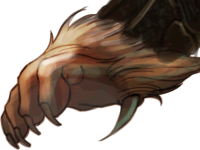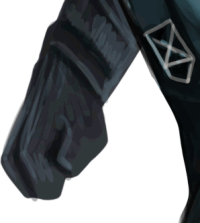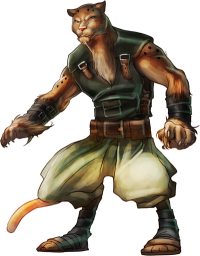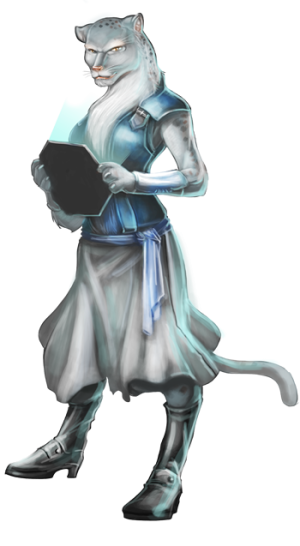Table of Contents
Jodau'lynuâ (Physiology)
This page provides information on the physiology races of the Poku Degonjo Saeruo (Hidden Sun Clan).
General Appearance
All members of the clan are covered in fur, it is thinner and finer in various places, such as face, hands. Their faces are normally narrow and definitely display their feline nature. Only their palms and bottoms of their feet are without fur. Mottling and striping patterns are common traits within a family.
| Attribute | Species | Details |
|---|---|---|
| Body fur | Qaktoro | colors are shades of black, brown, gray, and tawny. White is rare. |
| Tula | colors are shades of white, brown, gray, orange, and tawny. Black is rare. | |
| Qakla | colors are shades of black, brown, gray, and tawny. | |
| Tuoro | colors are shades of white, brown, gray, orange, and tawny. | |
| Eye Color | Qaktoro | ranges from pale blue, yellow, to brilliant green. |
| Tula | ranges from pale blue, orange, to violet. | |
| Qakla | ranges from pale blue, yellow, to orange. | |
| Tuoro | ranges from pale blue, yellow, to violet. | |
| Skin Color | Skin color is visible on the lips, inner ears, end of nose, hands and feet. | |
| Qaktoro | ranges from gray, white, tan, and black. | |
| Tula | ranges from gray, white, pink, and brown. | |
| Qakla | ranges from gray, white, tan, and pink. | |
| Tuoro | ranges from gray, white, pink, and black. | |
Physical Stats
| Qaktoro | |
|---|---|
| Males | 1.6 to 2.2 meters (5.24 to 7.2 feet) |
| Females | 1.6 to 1.9 meters (5.24 to 5.9 feet) |
| Weight range for males | 87 - 114 kg (191 - 272 lbs) |
| Weight range for females | 81 - 92 kg (178 - 202.4 lbs) |
| Typically are able to bench press 175% of their weight. | |
| Typically are able to lift their own weight. | |
| Tula | |
| Males | 1.2 to 1.6 meters (3.94 to 5.25 feet) |
| Females | 1.2 to 1.6 meters (3.94 to 5.25 feet) |
| Weight range for males | 65.96 - 91.12 kg (145.11 - 200.4 lbs) |
| Weight range for females | 61.88 - 69.36 kg (136.14 - 152.56 lbs) |
| Typically are able to bench press their own weight. | |
| Typically are able to lift 75% of their own weight. | |
| Qakla | |
| Males | 1.5 to 1.9 meters (5.24 to 6.2 feet) |
| Females | 1.3 to 1.6 meters (5.24 to 5.9 feet) |
| Weight range for males | 85.36 - 117.92 kg (187.79 - 259.42 lbs) |
| Weight range for females | 80.08 - 89.76 kg (176.18 - 197.47 lbs) |
| Typically are able to bench press 150% of their weight. | |
| Typically are able to lift their own weight. | |
| Tuoro | |
| Males | 1.5 to 1.9 meters (5.24 to 7.2 feet) |
| Females | 1.5 to 1.9 meters (5.24 to 5.9 feet) |
| Weight range for males | 73.72 - 101.84 kg (162.18 - 224.04 lbs) |
| Weight range for females | 69.16 - 76 kg (152.15 - 167.2 lbs) |
| Typically are able to bench press their own weight. | |
| Typically are able to lift 85% of their own weight. | |
Senses
Hearing
Ears are located high and towards the rear, on either side of their heads. They can move each ear individually to listen forward or behind; or to track the movement of a target. They have exceptional hearing, but only hear normal audio ranges.
Vision
During normal light pupils look feline. But in periods of low light, the pupil widens to allow more light, and their vision shifts towards the ultraviolet range. This gives them excellent night vision. Owing to their ancestry as predatory animals the Qaktoro and Tuoro do not see the color green, they perceive this color as shades of gray. the Tula and Qakla do see the color green.
Smell
Members of the clan retain a sensitive sense of smell. Their sense of smell is twice as sensitive as a human, and they can usually identify the components of a scent if they recognize them.
Taste
The Qaktoro sense of taste is actually rather weak. For this reason much of what they eat, and drink for pleasure tends to have strong flavors. Tula, Tuoro, and Qakla sense of taste is closer to human. They prefer their foods to be less seasoned than their cousins, but they can eat any Qaktoro meal.
Vit'taka (Plant Speech)
- All Tula have some form of Vit'taka (Plant Speech).
- Most Tuoro have some form of Vit'taka (Plant Speech).
- Qaktoro do not have Vit'taka (Plant Speech).
- It is rare but not unheard of for a Qakla to have some form of Vit'taka (Plant Speech). Though they would be reluctant to reveal this among Qaktoro.
Life Cycle
Estimated lifespan Barring mishap or death members of the clan have a life span of about 125 years.
Reproduction Is the result of sexual intercourse, gestation is 6 months. Females enter estrus four times a year. Qaktoro become fertile at 16-17 years of age. Single birth happens 80% of the time, twins are 17%, and more than that is 3%. Qaktoro are genetically compatible with Tula.
Body details
Hands
| Qaktoro & Tuoro hand features four thick fingers, and an opposable dewclaw that serves as their thumb. |  |
| Tula & Qakla hand features four thick fingers, and an opposable thumb in the dewclaw position. |  |
| Clan members do not have fingerprints as humans have, but their fingers do have pads and the patterns on them are unique. | |
| All clan members possess retractable finger claws. |
Skull
The skull is shorter than a human but the facial structure protrudes in an angular fashion belying their feline ancestry. They have pronounced canines (fangs) with females having the larger.
Breasts
Females only have pronounced breasts while nursing their offspring. They located approximately in the middle of the torso. They have a total of four teats which are located about mid-abdomen.
Eyes
| Qaktoro eyes are almond shaped with the point on the outside. The point is straight out from the pupil. |
| Tula eyes are almond shaped with the point on the outside. The point is slanted upwards at 30 degrees. |
| Qakla and Tuoro eyes are almond shaped with the point on the outside. The point is slanted upwards at 15 degrees. |
| All have a traditional feline shaped pupil in normal light, and in low light the pupil is round and most of the iris is hidden. |
Ears
Feet
Feet are broad and elongated to give them better balance. The foot has four toes. They have vestigial claws that do not retract and resemble toe-nails on humans except for the size.
Tail
All tails are prehensile which means they can manipulate objects. It emerges perpendicular to the spine so a individual can sit on a stool and not sit on their tail.
| Species | Manipulation | Length | Lift |
|---|---|---|---|
| Qaktoro | can not perform fine detail work | typically 33% of height | 15-20 kg |
| Tula | perform fine detail work 1) | typically 50% of height | 5-10 kg |
| Qakla | can not perform fine detail work | typically 33% of height | 15-20 kg |
| Tuoro | perform fine detail work 2) | typically 50% of height | 5-10 kg |
Diet
Qaktoro
Are omnivorous. But their normal diet tends to be heavy with meats with vegetables and fruit added for flavoring. The normal preference when it comes to meat ranges from raw to medium rare. A Qaktoro will only eat meat that is overcooked for survival. Offering a guest overcooked meat is a grave insult. The only thing worse is offering a Qaktoro nothing but vegetables; this is an insult strong enough to warrant a duel.
Tula
Are omnivorous. But their normal diet tends to be a balance between meats, vegetables and fruits. A Tula enjoys a wider range of how their meat is prepared. Among Tula etiquette is for the host to ask how their guest wants their meat. Tula are also perfectly comfortable eating a meal of just vegetables. But to maintain their health they must have meat as a part of their diet.
Qakla
Are omnivorous. But their normal diet tends to be heavy with meats with vegetables and fruit added for flavoring. The normal preference when it comes to meat ranges from raw to medium rare.
Tuoro
Are omnivorous. But their normal diet tends to be a balance between meats, vegetables and fruits. A Tuoro enjoy a wider range of how their meat is prepared.
Movement
- Running: Have a loping gait, using their powerful legs they opt for long strides for speed. They can maintain a loping gait longer than they can a sprint.
- Walking: Move with a feline grace.
- Swimming: Can swim and most learn basic swimming. Due to a very low body fat level they are non-buoyant by nature, floating can only be done with assistance devices.
- Zero-Gravity:
- Qaktoro are uncomfortable with low gravity it affects their sense of balance badly. So when possible they try to avoid it. Or they use curatives to counter the dizziness.

